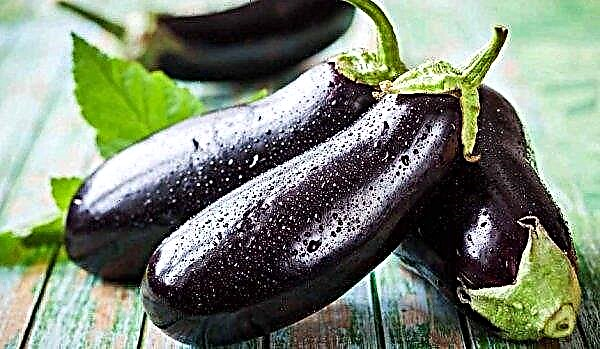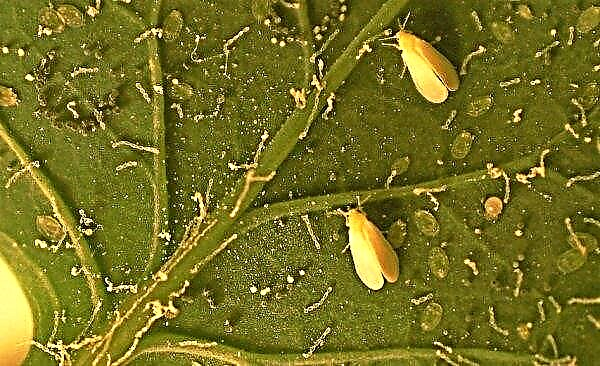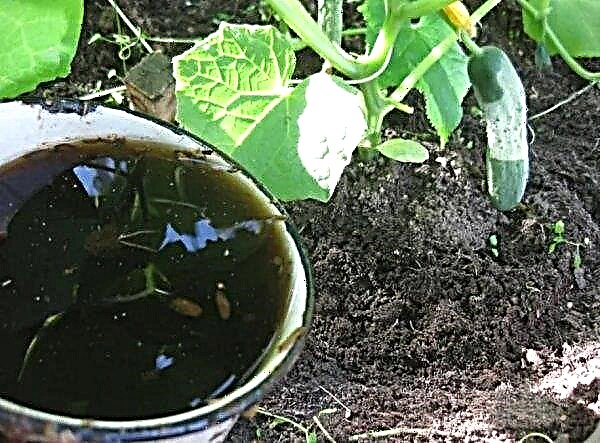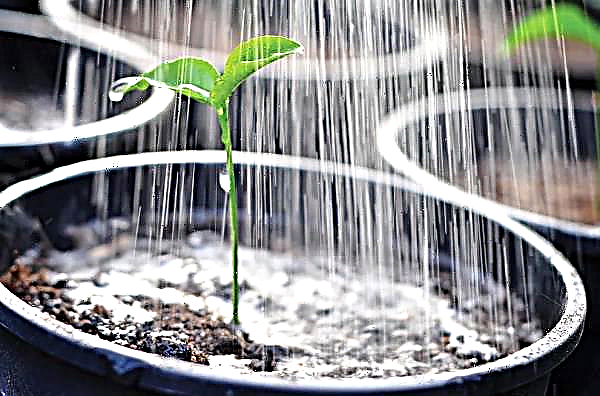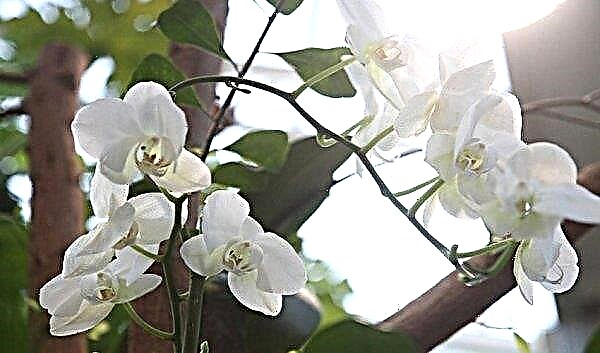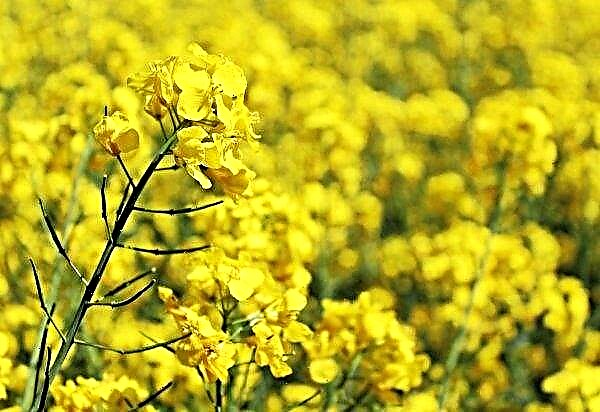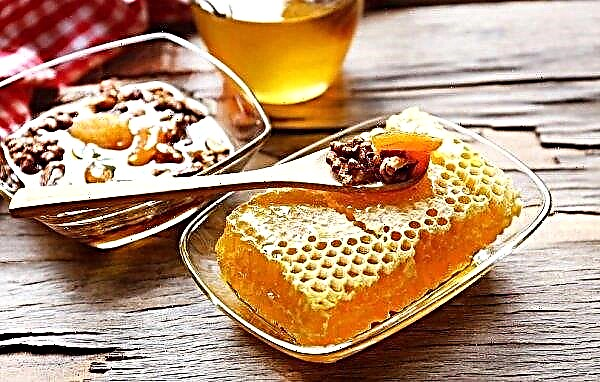One of the popular and easy to grow indoor plants is sanchetia. This article discusses what conditions for growth this decorative shrub requires, how to propagate it, what are the methods of combating diseases and pests of sanchezia.
Botanical description of the plant
Sanchezia is named after the Spanish botanist Jose Sanchez (18th century). Belongs to the genus Acanthaceae, in which there are approximately 20 species. The homeland of sanchezia is the tropical forests of Central and South America. In countries with a warm climate, it is grown as an ornamental shrub, in cooler areas it is cultivated as a houseplant.
Photo gallery
Outwardly, it is an evergreen bush with a very beautiful leaf pattern. The plant grows from 40 cm to 2 m, depending on the species, and forms highly branched shoots. Large oval leaves on the shoots are parallel to each other, petioles on the leaves are short, green in color with a yellow or cream pattern.
At the beginning of summer (June-July), flowering begins - inflorescences are formed on the plant in the form of dense flowering spiky panicles, up to 5 cm long. The inflorescences are located at the tips of the shoots. Each panicle consists of eight or ten tubular, yellow, orange or red flowers.
| Root system | extensive |
| Stem | herbaceous |
| Leaf shape | oval |
| Leaf color | green with a light (yellow or cream) pattern |
| Flower shape | spike-like, consists of many small flowers |
| Flower color | yellow, orange or red |
Did you know? It is believed that the Babylonian emperor Nebuchadnezzar was one of the first who "domesticated" wild plants, having built hanging gardens for his beloved wife to ease her longing for a distant home.
Main types
About 50 varieties of sanchezia have been found in the world, but only two species are valued by flower growers. They are most decorative and adapt well to indoor conditions.
- Sanchez is noble. Well-branched shrub, its shoots have a green skin with an admixture of pink. Adult bushes reach a height of 2 meters. The branches are covered with large oval leaves, dark green in color with a serrated edge. There is also a light pattern (yellow or cream) on the green leaf blade. Its length in an adult bush reaches 30 cm and a width of 10 cm. Such large leaves grow on bushes grown in the garden - in plants grown in a pot, the height, size of the leaves and the span of the branches are much smaller.

- Sanchezia is small-leaved. This species has a short bush, but lush and sprawling. The bark on the shoots is brown. The leaves are oval with a narrow tip and a smooth edge. There is also a light pattern with a pale pink tint on the sheet plate.

House growing conditions
When growing in a house, the ornamental shrub needs good lighting, maintaining elevated air temperature and humidity. Only under these conditions will Sanchez turn into a lush bush covered with large leaves with a bright pattern.
Lighting and ventilation
For the cultivation of sanchezia, a well-lit place in the house is chosen, however, in summer, direct sunlight should be slightly shaded with a tulle curtain.
Places with good illumination (20–25%) are usually located in the neighboring area with places in which the sun's rays fall. This will be the brightest place, but with a light intensity much weaker than with direct sunlight.
This tropical flower does not tolerate cold drafts, so they should be avoided. However, the room must be aired from time to time. For airing in the winter, it is advisable to choose warm weather and open the window for at least 15–20 minutes.
Temperature and humidity
The ideal temperature should be maintained in the range from + 18 ° C to + 25 ° C, without increasing or decreasing for a long period of time. If it has risen above an acceptable level, this is manifested in yellow and wilted leaves. Too low a temperature causes the appearance of soft and flabby leaves.
Sanchezia grows well with medium or slightly high humidity (from 50 to 70%). During the heating season, the natural humidity in the apartment is insufficient for most plants; this is especially problematic when the indoor flower is next to the radiator. Dry air provokes the appearance of dry leaves, so you need to maintain air humidity by spraying water from a spray gun or by installing an automatic humidifier near the plant.
Did you know? The practice of growing indoor plants became popular in the 17th century, when the English flower grower, Sir Hugh Platt, came up with a method of growing plants in greenhouses by using central heating pipes from the house. Soon after, in England and other countries began to build greenhouses and greenhouses for growing exotic plants.
Home Care
To grow sanchezia in an apartment, it is necessary to provide the shrub with the care necessary for its growth and well-being: nutritious soil, periodic top dressing, pruning, plentiful watering and transplanting when the roots become crowded in a pot.
Watering
Indoor sanchezia requires a lot of moisture from March to November. The temperature of water for irrigation should not be lower than room temperature, otherwise it can cause a temperature shock in the plant. In the intervals between irrigation, only the top layer of the substrate should slightly dry - when growing shrubs, even short dry phases of the soil should be avoided.
Watering is plentiful - so that the earthen lump is completely moistened, water begins to flow out of the drainage hole and accumulate in the pan. Excess moisture drains into the pan about 20 minutes after watering, and it is poured. Moisture must not be allowed to accumulate in the lower part of the flower pot. To avoid this, a 2 cm thick drainage layer is placed at the bottom of the pot. Expanded clay balls or shards from ceramic dishes are suitable as drainage. Even hygrophilous plants suffer when the roots remain in the water for a long time, as waterlogging quickly leads to root rot.
The most convenient is watering the bush under the root at the same time as the surface moistening of the leaves by spraying. But lower watering is also possible: in this case, water is poured into the sump, and moisture gradually enters the roots of the shrub through the drainage holes. In winter, sanchezia is watered only moderately. Water for irrigation should be, as in summer, at room temperature. Before watering, let the topsoil dry to a depth of about 2 cm, while the inner layer of the soil should always remain slightly moist, not completely dry. When the top layer of the substrate becomes very dry, the flower is watered.
In winter, sanchezia is watered only moderately. Water for irrigation should be, as in summer, at room temperature. Before watering, let the topsoil dry to a depth of about 2 cm, while the inner layer of the soil should always remain slightly moist, not completely dry. When the top layer of the substrate becomes very dry, the flower is watered.
When watering, you need to give the flower so much water that the earth in the pot becomes evenly moistened, but not oversaturated. The signal to stop the irrigation is the appearance of the first drops of water from the drainage hole. Excess water is drained from the pan after a quarter of an hour. In addition, weekly leaves of the bush are sprayed with warm water.
For irrigation, it is advisable to use warm, settled tap water, or rain (snow). Hard or cold irrigation water harms plants.
Important! Even in winter, the florist should not forget about the timely watering of sanchezia, since the dried soil in the pot and the dryness of the root system are no less harmful to it than waterlogging.
Top dressing
From spring to autumn, under sanchezia, a solution of fertilizer for indoor plants, diluted in accordance with the manufacturer's instructions, is added to every fourth watering. In winter, fertilizers are applied less frequently; during the period from November to March, one to two top dressings per month are carried out. Before applying liquid fertilizer, the soil in the pot is previously lightly watered. Fertilizing in dry soil leads to the fact that the root system of the shrub can be burned, so be sure to adhere to the dose indicated by the manufacturer on the package.
In winter, fertilizers are applied less frequently; during the period from November to March, one to two top dressings per month are carried out. Before applying liquid fertilizer, the soil in the pot is previously lightly watered. Fertilizing in dry soil leads to the fact that the root system of the shrub can be burned, so be sure to adhere to the dose indicated by the manufacturer on the package.
Excess fertilizer can lead to overfeeding - signs of depression will appear on the shrub, plant development and growth may stop. In especially difficult cases, this can lead to the death of sanchezia.
Signs of nutritional deficiencies:
- bush growth stops, young leaves and buds do not form on it;
- old leaves fall and new ones do not grow;
- the bush does not bloom;
- Gloss disappeared from the sheet plate;
- the stems are thinned;
- lost turgor (internal pressure).
Pruning
Sanchezia tolerates pruning without problems - this operation only adds decorativeness and splendor to the bushes, which after it begin to branch well. When pruning, too long shoots are reduced to 2/3 of their original length. Pruning of plant shoots is done with a sharp knife, the blade of which is disinfected in an alcohol solution before starting work; instead of a knife, you can use a garden pruner or special scissors. Directional pruning contributes to the formation of a sanchezia bush. If it is not carried out, the stems of the bush grow too long, the plant does not branch and partially loses its beauty.
Directional pruning contributes to the formation of a sanchezia bush. If it is not carried out, the stems of the bush grow too long, the plant does not branch and partially loses its beauty.
Important! Abundant anti-aging pruning will help potted shrubs, which have lost their decorative effect, after a while, the trimmed bush will grow a new magnificent crown.
Transfer
The bushes grow very quickly and may require transplanting into slightly larger pots, even within one year, as soon as the old container is braided by roots. Pots can be made of ceramic, plastic, wood or glass. Each pot must have one or more openings for draining excess water. The size of a container suitable for transplantation is simple to determine: the roots of the plant are freely located in the pot, at least 2 cm remains between the root system and the walls of the pot.
A transplant is necessary if:
- the pot became too small for the bush;
- a donkey and a condensed drainage layer;
- the pot is completely braided by roots;
- roots go to the surface of the soil.
 For the successful cultivation of shrubs, a soil mixture is prepared consisting of:
For the successful cultivation of shrubs, a soil mixture is prepared consisting of:- 2 parts of sheet land;
- 1 part white, coarse sand;
- 2 parts of turf land;
- 2 parts of humus.
To transplant a flower, you must:
- Carefully remove the bush from the pot.
- Shake off the old soil from the roots, examine them and cut off all the dead roots. If necessary, you can trim even several living roots.
- Put drainage on the bottom of the pot with a layer of 2 cm, then fill the pot to half. Next, put a bush in the center of the pot, which is replanted, and fill the roots with earth. For the convenience of future irrigation, the soil in the pot should not reach the edge of the tank by 1 cm.
- Planted shrubs are abundantly watered, waiting for excess water to drain into the pan, and remove them.
- The transplanted plant must be placed in a place where it will be protected from direct sunlight for 2-3 weeks.
 A successfully transplanted bush is quickly restored, and in the near future resumes growth.
A successfully transplanted bush is quickly restored, and in the near future resumes growth.Important! The first 3 months after transplantation, domestic plants do not fertilize.
Propagation by cuttings
In early spring, you can start propagating sanchezia by the method of cuttings:
- The tops of the stems are taken as cuttings. At least three nodes must be present on each handle; the cut is made 1 cm under the third node, after which the lower leaves are removed from them.
- Cuttings are planted (1/3 of the length in the substrate) in a small seedling box filled with a mixture of equal parts of peat and sand. Soil temperature should be between + 20 ° C and + 25 ° C.
- The substrate with cuttings is moderately watered, the soil in the nursery should be slightly moist.
- A plastic film is pulled over a seedling box with cuttings. The nursery is placed in a bright, but not sunny place.
- Every three days, the polyethylene in the nursery is opened for 15 minutes to air the soil. If this is not done, the soil may become moldy. As necessary, the substrate is slightly moistened.
- When the cuttings are well rooted, they are transplanted from the nursery into separate pots. The soil for young plants is taken exactly the same as for adult sanchezia. For planting a seedling, a 0.5-liter pot is enough.
 Since old bushes lose their decorativeness, approximately every 2-3 years, flower growers replace them with new seedlings grown from cuttings.
Since old bushes lose their decorativeness, approximately every 2-3 years, flower growers replace them with new seedlings grown from cuttings.Important! The flower grower can be sure that the cuttings are well rooted, only if new leaves appear on them and the upper bud starts to grow.
Possible growing difficulties
Sanchezia, growing in pots, is mainly affected by root rot. If this disease is not treated, it will lead to the death of the plant. Since its first symptoms appear under the soil, the problem can not be noticed for a long time.  Clear symptoms are yellowing of leaves or stunting. Rot develops on the roots of plants growing in too dense soils, or in containers that do not have sufficient drainage holes. In the worst cases, when the conditions are ideal for the rapid development of fungal spores and their spread, the flower may die within 10 days.
Clear symptoms are yellowing of leaves or stunting. Rot develops on the roots of plants growing in too dense soils, or in containers that do not have sufficient drainage holes. In the worst cases, when the conditions are ideal for the rapid development of fungal spores and their spread, the flower may die within 10 days.
If the symptoms of the disease are similar to root rot, you need to remove the plant from the pot, carefully brush the roots off the soil and inspect them for rot. The flower cannot be preserved if the entire root system has already become soft, but if there are healthy white, firm roots, it will be possible to cure the plant by replanting it in fresh soil with good drainage at the bottom of the pot.
Of insects that damage plants, sanchezia is attacked by scale insects and aphids. Aphids (Aphidoidea) are brought into it by ants and placed on the back of the leaf. These insects have a size of up to 2 mm, the color of chitin can be different: green, black, whitish, pink. It feeds on aphids with the juice extracted from the leaves of plants, after which they turn yellow, dry out and fall off. Aphids multiply rapidly, so immediately after detection it is necessary to clean the plant from it. There are several ways to clean it:
There are several ways to clean it:
- rinse with water from a shower head;
- wipe the plant with a soapy sponge;
- treat the bush with one of the insecticides ("Aktara", "Calypso", "Presto").
Important! Insecticide treatment of the shrub must be carried out outside the home.
Scabies (Diaspididae) - also sucking insects that feed on leaf juice. Their presence on the plant can be determined by the appearance of many small yellow spots, which soon increase. Damaged leaves dry and crumble. With a large population of shields, the bush dies. The shield has a rounded brown shell in the form of a plaque and is clearly visible on a green background of leaves - these insects are easy to recognize, but difficult to destroy with insecticides, since pests hide under the shield of the shell. The most effective method is to apply an aqueous soap solution to the leaves and petioles with the addition of alcohol (15 grams of liquid soap and 10 ml of alcohol are dissolved in 1 liter of water). This solution is applied using a soft toothbrush, which the grower simultaneously removes from the sheet of masonry eggs of the scutellum.If the shrub is heavily infected with scale insects, it is taken out of the room and then treated with chemical preparations (Actellik, Fosbetsid, Aktara).
The shield has a rounded brown shell in the form of a plaque and is clearly visible on a green background of leaves - these insects are easy to recognize, but difficult to destroy with insecticides, since pests hide under the shield of the shell. The most effective method is to apply an aqueous soap solution to the leaves and petioles with the addition of alcohol (15 grams of liquid soap and 10 ml of alcohol are dissolved in 1 liter of water). This solution is applied using a soft toothbrush, which the grower simultaneously removes from the sheet of masonry eggs of the scutellum.If the shrub is heavily infected with scale insects, it is taken out of the room and then treated with chemical preparations (Actellik, Fosbetsid, Aktara).
Signs and superstitions
Folk rumor awarded some indoor plants with mystical properties. There are many signs and superstitions associated with the presence of potted flowers in the house.
Common superstitions and signs:
- an apartment where indoor flowers are constantly dying has negative energy; a dried plant indicates that it has taken upon itself damage directed at the owners of the house;
- flowers do not grow in a house where scandals constantly arise;
- a flower pot can help identify negative areas in the house - do not place a bed where the flower withers;
- unusual flowering of a home plant out of season - (according to various interpretations) means both pleasant surprise and sudden death;
- a money tree (fat woman) in an apartment contributes to the emergence of sustainable financial well-being, but only if, when planting it, put a few coins in a pot;
- it is not customary to hand the plants in the pot as a gift - it is believed that this contributes to the transition of problems from the donor to the gifted, therefore, the person who received the gift must be given any small coin in return.
 Elegant and painted greenery of the lush crown of a tropical shrub will decorate any interior. For this, the grower should provide sanchezia with full care, suitable temperature, humidity and bright lighting.
Elegant and painted greenery of the lush crown of a tropical shrub will decorate any interior. For this, the grower should provide sanchezia with full care, suitable temperature, humidity and bright lighting.




